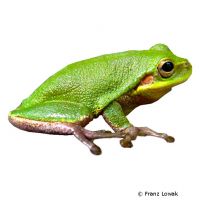Squirrel Treefrog (Hyla squirella)
| Squirrel Treefrog Hyla squirella | |
|---|---|
| Name | Squirrel Treefrog |
| Name Lat. | Hyla squirella |
| Family | Hylids |
| Family lat. | Hylidae |
| Order | Frogs & Toads |
| Order lat. | Anura |
| Origin | North America |
| Habitat | Wetlands |
| Diet | Small live insects |
| Humidity | 70-80 % |
| Behavior | Peaceful, nocturnal |
| Keeping | Pair, group |
| Care Level | Easy |
| Breeding | Moderately difficult |
| Housing | Semi-humid terrarium |
| Life Span | 5-10 years |
| Protection | No |
| Metric Units | |
| Size | 3-4 cm |
| Temperature | 24-28 °C |
| Housing Size | 30 x 25 x 50 cm |
| US Units | |
| Size | 1.2"-1.6" |
| Temperature | 75-82 °F |
| Housing Size | 10" x 10" x 20" |
Distribution and habitat
The range of nocturnal squirrel tree frogs is the southeastern United States, from North Carolina to Texas and Florida, where they live in sparse forests, savannas, and meadows, as well as gardens with many hiding places near standing or slow-moving water.
Maintenance
For 1-3 animals, the minimum terrarium area is 750 cm², with a minimum effective height (measured without substrate) of 40 cm. This corresponds to a base area of e.g. 30 x 25 cm. For each additional animal, provide an additional 200 cm² of surface area and 2 cm of height. The terrarium should be placed in a quiet place without sunlight.
You will need a terrarium with a substrate of loose, absorbent, non-rotting substrate such as. Sand-peat mixture, coconut fibers or Sphagnum moss with a drainage and a shallow watering place as large as possible, in addition branched climbing branches, preferably entwined by climbing plants, with horizontal perches, back and side wall coverings of e.g. tree fern plates (Xaxim) and a dense planting (e.g. Tradescantia, Ficus, Scindapsus, ferns). Potted plants that can be easily removed for cleaning are advantageous. At least twice a day the inside of the terrarium must be finely sprayed with water (humidity), but a rain or mist system is better.
| Temp. day: 24-28 °C | Temp. night: 20-22 °C | Humidity: 70-80 |
The lighting duration must be 10-14 hours depending on the season. Daylight fluorescent tubes with low UV content are very suitable. Recommended is a hibernation of about 2 months, during which, depending on the origin of the animals, the temperature is lowered to 8-15 °C.
Diet
The food supply consists of live insects such as house crickets, houseflies and cockroaches as well as small grasshoppers and crickets. After a period of habituation (feeding with tweezers), special ready-made food for insectivores is often accepted as well. Food should be offered to adult animals 2-3 times a week, young animals must be fed daily. It is important to add minerals and vitamins regularly (e.g. by dusting the feed animals). The quality of the feed animals can be upgraded by feeding overripe fruit and honey water.
A varied diet promotes health and prevents deficiency symptoms.
Reproduction and breeding
Males and females can hardly be distinguished externally. Males remain slightly smaller.
After winter dormancy, the female ready to spawn is taken by the male in the mating grip (amplexus) and lays over 1000 eggs in spawning pads, usually in shallow standing water with dense vegetation. The larvae (tadpoles) hatch after only 1-2 days. They initially filter microorganisms from the water and later eat animal and plant food. After about 40-50 days the transformation (metamorphosis) is completed and the frog leaves the water.
The life expectancy can be 9 years.
Important
The squirrel tree frog can adapt the coloration of its skin to the environment and thus protect itself from predators. They are very sociable animals and keeping them in a group of at least 5 is recommended.
Before purchasing, a terrarium should be prepared that meets the species specific needs. Good ventilation without drafts is necessary, as well as equipment for measuring temperature and humidity. The lighting has to correspond to the species-specific day-night rhythm and should be placed in such a way that the animals cannot injure themselves. The terrarium should be locked in such a way that neither unauthorized persons can open it nor the animals can escape. Special attention must be paid to thorough hygiene and impurities must be removed regularly
Further literature can be found in your pet store.
References
Text: petdata; Image: Franz Lowak
Source: VDA & DGHT (2006): Haltungsrichtlinien für die Haltung von Anuren; ENGELMANN (2006): Zootierhaltung - Tiere in menschlicher Obhut: Reptilien und Amphibien, Harri Deutsch Verlag
- Gemäß § 21 Abs. 5 Tierschutzgesetz idgF
